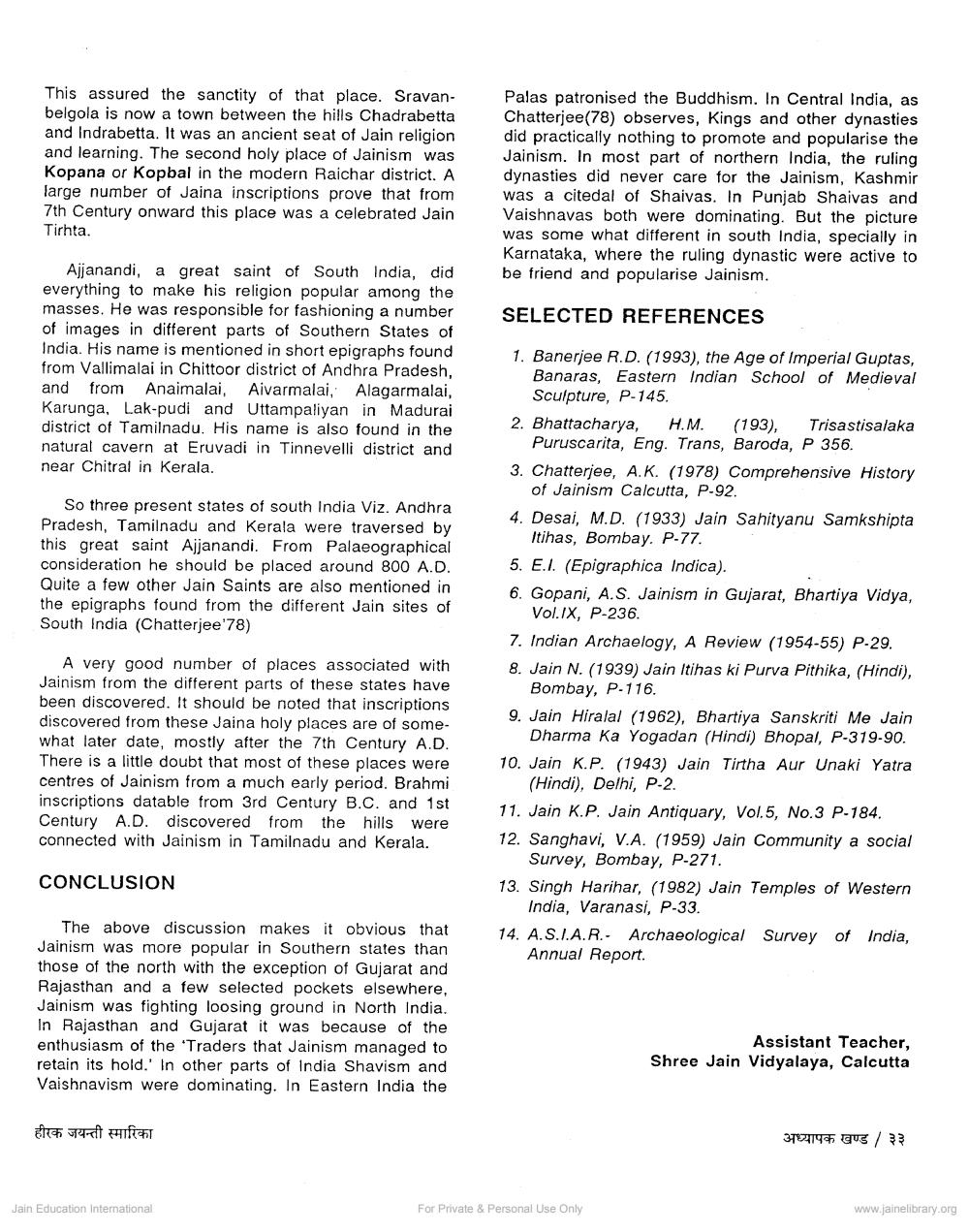________________ This assured the sanctity of that place. Sravanbelgola is now a town between the hills Chadrabetta and Indrabetta. It was an ancient seat of Jain religion and learning. The second holy place of Jainism was Kopana or kopbal in the modern Raichar district. A large number of Jaina inscriptions prove that from 7th Century onward this place was a celebrated Jain Tirhta. Palas patronised the Buddhism. In Central India, as Chatterjee(78) observes, Kings and other dynasties did practically nothing to promote and popularise the Jainism. In most part of northern India, the ruling dynasties did never care for the Jainism, Kashmir was a citedal of Shaivas. In Punjab Shaivas and Vaishnavas both were dominating. But the picture was some what different in south India, specially in Karnataka, where the ruling dynastic were active to be friend and popularise Jainism. SELECTED REFERENCES Ajjanandi, a great saint of South India, did everything to make his religion popular among the masses. He was responsible for fashioning a number of images in different parts of Southern States of India. His name is mentioned in short epigraphs found from Vallimalai in Chittoor district of Andhra Pradesh, and from Anaimalai, Aivarmalai, Alagarmalai, Karunga, Lak-pudi and Uttampaliyan in Madurai district of Tamilnadu. His name is also found in the natural cavern at Eruvadi in Tinnevelli district and near Chitral in Kerala. So three present states of south India Viz. Andhra Pradesh, Tamilnadu and Kerala were traversed by this great saint Ajjanandi. From Palaeographical consideration he should be placed around 800 A.D. Quite a few other Jain Saints are also mentioned in the epigraphs found from the different Jain sites of South India (Chatterjee'78) 1. Banerjee R.D. (1993), the Age of Imperial Guptas, Banaras, Eastern Indian School of Medieval Sculpture, P-145. 2. Bhattacharya, H.M. (193), Trisastisalaka Puruscarita, Eng. Trans, Baroda, P 356. 3. Chatterjee, A.K. (1978) Comprehensive History of Jainism Calcutta, P-92. 4. Desai, M.D. (1933) Jain Sahityanu Samkshipta Itihas, Bombay. P-77. 5. E.l. (Epigraphica Indica). 6. Gopani, A.S. Jainism in Gujarat, Bhartiya Vidya, Vol.IX, P-236. 7. Indian Archaelogy, A Review (1954-55) P-29. 8. Jain N. (1939) Jain Itihas ki Purva Pithika, (Hindi), Bombay, P.116. 9. Jain Hiralal (1962), Bhartiya Sanskriti Me Jain Dharma Ka Yogadan (Hindi) Bhopal, P-319-90. 10. Jain K.P. (1943) Jain Tirtha Aur Unaki Yatra (Hindi), Delhi, P-2. 11. Jain K.P. Jain Antiquary, Vol.5, No.3 P-184. 12. Sanghavi, V.A. (1959) Jain Community a social Survey, Bombay, P-271. 13. Singh Harihar, (1982) Jain Temples of Western India, Varanasi, P-33. 14. A.S.I.A.R.- Archaeological Survey of India, Annual Report. A very good number of places associated with Jainism from the different parts of these states have been discovered. It should be noted that inscriptions discovered from these Jaina holy places are of somewhat later date, mostly after the 7th Century A.D. There is a little doubt that most of these places were centres of Jainism from a much early period. Brahmi inscriptions datable from 3rd Century B.C. and 1st Century A.D. discovered from the hills were connected with Jainism in Tamilnadu and Kerala. CONCLUSION The above discussion makes it obvious that Jainism was more popular in Southern states than those of the north with the exception of Gujarat and Rajasthan and a few selected pockets elsewhere, Jainism was fighting loosing ground in North India. In Rajasthan and Gujarat it was because of the enthusiasm of the Traders that Jainism managed to retain its hold.' In other parts of India Shavism and Vaishnavism were dominating. In Eastern India the Assistant Teacher, Shree Jain Vidyalaya, Calcutta हीरक जयन्ती स्मारिका अध्यापक खण्ड / 33 www.jainelibrary.org Jain Education International For Private & Personal Use Only




